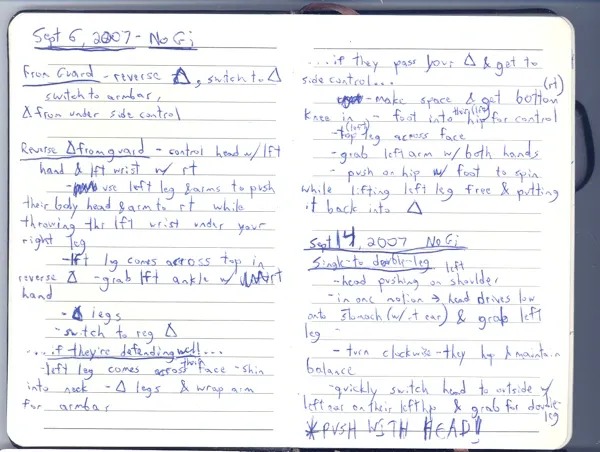- 253 Grande Heights Drive, Cary, NC 27513
- 919-432-9500
- Email Us




 I have always encouraged students to take notes during class. Why? Because I cover details that are directly linked to the belt exams that they are required to take (if they do not compete regularly) in order to get promoted.
I have always encouraged students to take notes during class. Why? Because I cover details that are directly linked to the belt exams that they are required to take (if they do not compete regularly) in order to get promoted.
I also want students to get the most out of each training session.
However, I realized that the problem with taking notes during class is that students will scribble details, and then never look at the notes again. This is not beneficial for memory retention.
In fact, research shows that recalling information after the fact is better for memory retention than passively writing details down as you hear them.
So, I have started to send out a weekly technique review to all of my students through email. It lists the drills and names of the techniques that we discussed, but it does not include any of the details of the technique.
My hope is that students will see the list in the weekly review, and then fill in the details themselves. This requires students to think back to the class and what was taught. They will need to ask themselves, “what do I remember about this technique?”
By practicing memory recall and writing down what they remember after the fact, they are more likely to retain the information and remember it for when they are rolling.
Here is an example of what a student’s notes might look like after this week’s review:
As you can see, the notes are not perfect. They are just what comes to mind when you try to remember what we drilled in class.
I also want to emphasize that there will be some techniques that just did not click for you, and others that make sense.
Really focus on the ones that make sense, and do not stress too much about the ones that left you confused. I show a handful of variations because I know that some people will prefer one technique to another, and that it differs from student to student.
Focus and pay attention to the techniques that make sense and feel comfortable to you. These are the ones you will be more likely to use in a roll anyways.
Try recalling details for the techniques in the Weekly Review for at least a month, and see how it improves your jiu jitsu!
As a reminder, here are some of the upcoming events at the gym:
Keep an eye out on the blog for gym updates or follow us:
Instagram: @tonycasarez | @lepribjjraleigh
Facebook: Tony Casarez | Lepri BJJ Raleigh
Youtube Channel: Tony Casarez
Copyright © 2024 Casarez Brazilian Jiu-Jitsu. All rights reserved. Website designed by Addicott Web.